Have you ever dreamed of escaping to a sunny villa in the heart of Italy, vineyards and rolling hills stretching out all over? That need for warmth, authenticity, and link to the earth is precisely what the Tuscan style house embodies. Highly discussed in regards to rustic elegance and old-world sophistication, this look has drawn homeowners for decades. But in a world where modern, sleek appearances reign supreme, is the Tuscan house style still fashionable, or does it have its time in the past? Let’s pop the lid off the secrets of this beloved fashion and find out why it’s still so in style.
For others, the phrase Tuscan home style brings to mind cozy kitchens, plush textures, and a cozy, inviting atmosphere. It’s an aesthetic of coziness, warmth, and the charm of the natural world. It’s more than a stylistic detail, though, but a lifestyle, inviting you to linger, take pleasure in the present, and envelop yourself in the people and things you care about. But how do you achieve that real, lived-in quality without your home resembling an amusement park? We’re going to explore the fundamentals and modern interpretations of this so utterly irresistible design.
Table of Contents
The Soul of Tuscan Home Design: Rustic Elegance and Cozy Warmth
Tuscan home design at its heart is all about bringing in the beauty and richness of the Tuscan countryside. It’s about loving natural materials, the natural colors of the earth, and a sense of history.
The Earthy Color Scheme: Colors That Tell a Story
The traditional Tuscan house color scheme is taken straight from the Italian landscape. Think of the terracotta-colored roofs, golden fields, rich greens of the cypress trees, and rich reds of the locally grown wines.
- Warm Neutrals: Beige, cream, sand, and stone shades that form the foundation, a light but earthy background.
- Terracotta and Ochre: These warm, earthy colors are timeless, seen in tiles, ceramics, and the walls of plaster houses. They at once suggest the sun-dried condition of the region.
- Deep Greens and Blues: The olive greens, sage, and sky blues applied as accents bring in the natural tones of the Tuscan landscape.
- Golds and Rich Reds: Those rich, deeper colors that evoke wine and sunsets add warmth and a touch of rich depth, usually to finishes or textiles.
Natural Materials: The plinth of Tuscan Design
Nothing is more significant to Tuscan house design than its emphasis on natural, robust materials. They are not finishes; they are the foundation of the aesthetic and sensibility.
- Terracotta and Stone: From rough stone walls and rural fireplaces to terracotta floor tile (a signature!), these materials ground the space and add undeniable personality. The subtleties of natural stone and the warm, earthy texture of terracotta create an honest, aged atmosphere.
- Wood: Dark, distressed wood fills every nook and cranny, from exposed ceiling beams to solid furniture and broad-plank flooring. The imperfections and patina of aged wood are highly prized, contributing to the lived-in look.
- Wrought Iron: In use for lighting, railings, and furniture trim, wrought iron creates a feeling of rustic loveliness and solidity, harmonizing perfectly with softer surfaces.
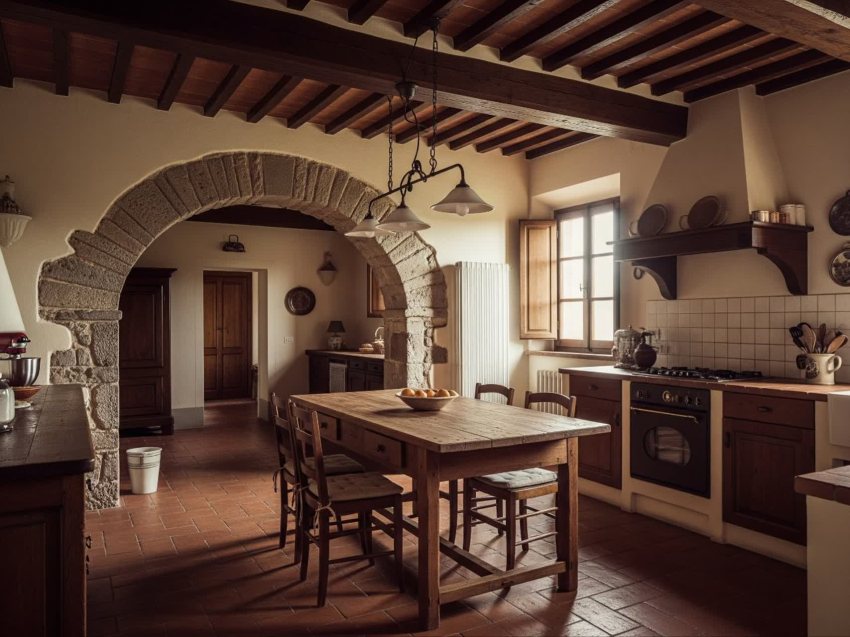
Defining Elements of a Tuscan Home Style Interior
To bring the spirit of Tuscany into your home, look to these defining elements that reach beyond surface ornamentation.
Rustic Furnishings: Comfort and Character
Furniture in Tuscan home style is solid, comfortable, and often looks like it’s been passed down through the family.
- Thick, Distressed Wood: Farm tables featuring heavy, thick legs, solid chairs, and big cabinets crafted from dark, aged wood are common. Distressed finishes and visible wood grain are preferred over sleek, modern styles.
- Wrought Iron Accents: Chairs featuring wrought iron frames, ornate bedframes, and console tables often include this sturdy and decorative material.
- Upholstery: In the midst of all the wood and iron, upholstery invites natural fabrics like linen or cotton in warm, earthy tones or with traditional patterns like stripes or subtle florals. Plush, comfortable sofas come to mind.
Architectural Details: Evoking Old-World Charm
Certain architectural details are synonymous with Tuscan home style and are mostly responsible for its unique charm.
- Exposed Beams: Dark, rough-hewn wooden beams on ceilings instantly add character and a feeling of genuineness.
- Arched Openings: Doorways, windows, and even interior openings often feature beautiful arches, rounding lines and bringing in a classic Italian feel.
- Textured Walls: Stucco, plaster, or faux finishes that evoke aged stone or lime wash are common, adding depth and an organic, handmade feel. (If you’re interested in a bold contrast in forms and textures, you might like our post on brutalist interior design guide).
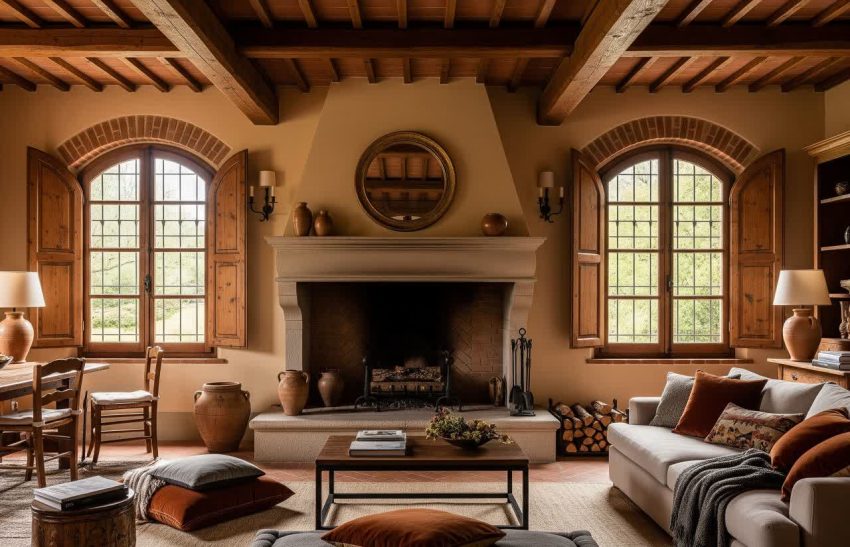
Lighting: Warm and Inviting Atmosphere
Lighting in Tuscan home design is all about creating a warm, welcoming glow that contributes to the rustic atmosphere.
- Wrought Iron Fixtures: Wrought iron chandeliers, wall sconces, and floor lamps often feature intricate wrought iron work with amber or frosted glass for warm light diffusion.
- Ambient Lighting: Multiple sources of light at different heights create a layered effect and avoid glary overhead lighting. Think table lamps, floor lamps, and even candles.
- Natural Light: Large windows, typically with wood shutters, are a requirement to allow ample natural light to flow in, highlighting the textures and colors.
Modern Tuscan Home Style: A New Spin on Tradition
While traditional Tuscan home style is very much a product of its rustic origins, modern Tuscan home style puts a new spin on it, blending classic elements with contemporary sensibilities. It’s all about sophistication without losing its essence.
Striking a Balance between Rustic and Refined
Modern Tuscan home style is somewhat more pared-down in approach, favoring quality over quantity and cleaner lines without sacrificing the natural warmth.
- Lighter Palettes: Earth tones continue to dominate but modern interpretations might lean towards slightly lighter beiges, creams, and grays with perhaps shots of deeper color for accent.
- Sleeker Finishes: While natural materials are still a priority, finishes can be a bit more polished. For instance, less distressed wood or less rough-hewn stone surfaces.
- Curated Decor: Instead of numerous decorative items, modern Tuscan interiors can include fewer, more statement-making pieces, thoughtfully chosen for their craftsmanship and adherence to the aesthetic.
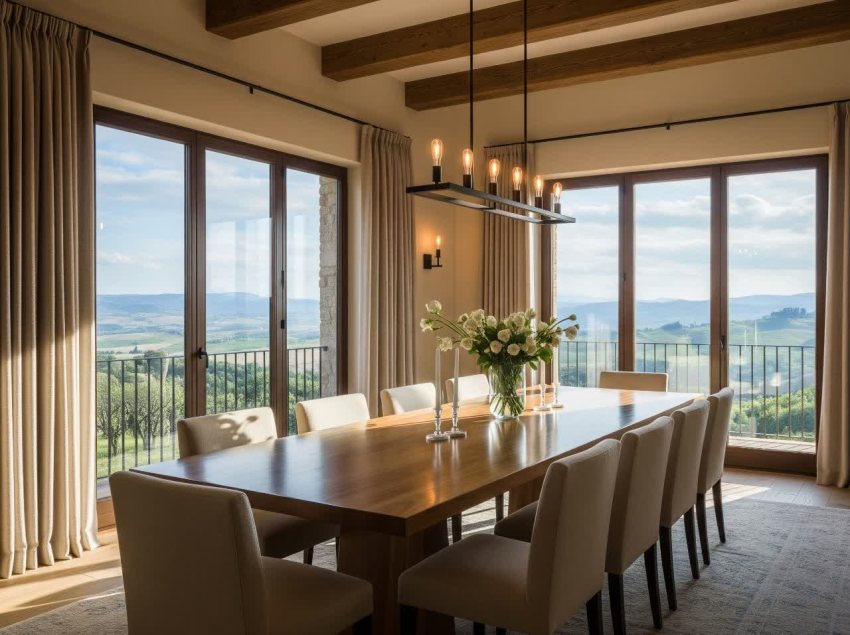
Creating a Tuscan Home Style Living Room: Actionable Steps
Transforming your living room into a cozy Tuscan retreat is achievable with some thoughtful changes:
- Warm Wall Colors: Begin with a warm beige, cream, or pale terracotta base. A faux plaster finish can add texture.
- Natural Flooring: Terracotta tiles, wide wood planks, or stone are ideal if feasible. Otherwise, large area rugs with natural fibers (sisal, jute) or classic patterns can do the trick.
- Comfortable Seating: Choose heavy, plush sofas and armchairs. Upholstery in linen, chenille, or earth-toned subtly patterned fabric is appropriate.
- Wooden Furniture: Employ a rustic coffee table, side tables, or an entertainment unit in distressed dark wood.
- Wrought Iron Accents: Add a wrought iron chandelier, sconces, or use wrought iron decorative accents like a fire screen.
- Strategic Decor: Display ceramic pottery, large decorative urns, woven baskets, and traditional artwork (landscapes, still life). And include one large, bold mirror with a distressed frame.
- Textiles: Incorporate warm-toned throws and pillows, perhaps with narrow stripes or florals.
- Add Greenery: Olive trees (if the climate permits), potted herbs, or lush indoor plants add life and connect to the natural world.
The Role of Outdoor Spaces in Tuscan Home Design
For a truly Tuscan home design, the integration of indoor and outdoor living is critical. Think courtyards, patios, and pergolas.
- Terracotta Pots: Overflowing with brightly colored geraniums, olive trees, or fragrant herbs.
- Wrought Iron Furniture: Heavy and handsome, perfect for dining alfresco or lounging.
- Stone Pathways: Winding from one area of the garden to another or to the front door.
- Water Features: A small fountain will add a soothing sound and a point of interest (Source).
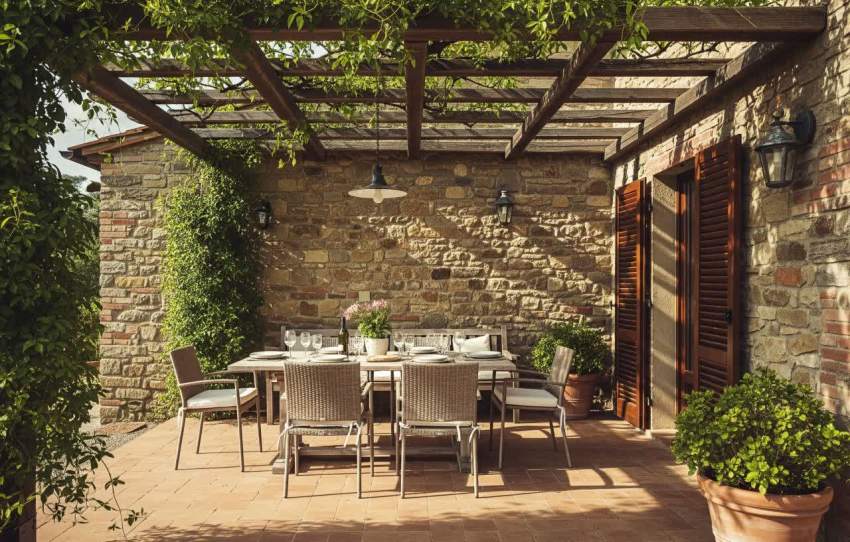
The Nuances Discussed: Tuscan Home Style in Context
To most appreciate the appeal and staying power of Tuscan home style, it’s useful to have a sense of its place in general design trends as well as how it diverges from similar aesthetics.
Tuscan Home Style vs. Mediterranean Style: What’s the Difference?
Although often confused, Tuscan home style is actually a type of Mediterranean design.
- Mediterranean Style: This is a broader category with design elements from various countries bordering the Mediterranean Sea, including Greece, Spain, Morocco, and the Middle East. It is characterized by whitewashed walls, pale blues, mosaic tile, and sometimes more intricate, geometric patterns.
- Tuscan Home Style: Special attention is given here to the style traditions of Tuscany, Italy. It is characterized by its utilization of earth tones, distressed and aged finishes, terracotta, exposed wood, and a more formal but still inviting elegance. It will be warmer and heavier in character than some of the other Mediterranean styles. (To view more on how to produce a distinctive ambiance, contrast this with our article on Japanese home style).
The Timelessness of Tuscan Home Style
Why do I think Tuscan home style survives even as styles arrive and depart? I believe it’s because it speaks to something primordial we want in our houses: history, comfort, and authenticity. In a time of speed fashion and disposable anything, Tuscan design values longevity, handiwork, and items that grow more fascinating with age. It encourages a slower pace of life, harmony with the environment, and care in collecting and sharing. It’s an appearance that quite literally invites you to put your feet up and stay a while.
- Timeless Beauty: Its construction with natural materials and classic shapes ensures it won’t date itself quickly. Think about how a well-made leather sofa or wood table matures with time.
- Adaptability: It has a certain look, but provided the basics are honored, it can be adapted to whatever home size and configuration, from large villas to tiny apartments.
- Emotional Appeal: It’s a style that evokes sentimentality, warmth, and earthiness – qualities that have tremendous appeal to human feeling.
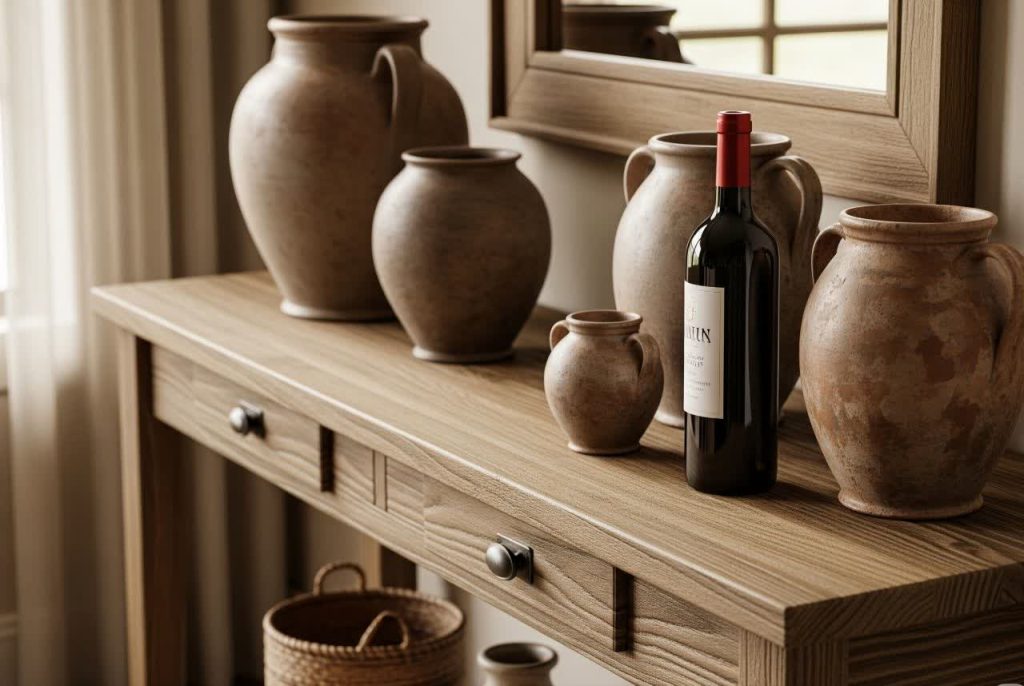
Summary: Designing Your Tuscan Haven
Embracing Tuscan home design is not merely about painting your walls ochre; it’s about establishing a setting of warmth, authenticity, and enduring appeal. Through the incorporation of organic materials like stone, wood, and terracotta, an earthy color palette, substantial and plush furnishings, and incorporating architectural elements like arches and exposed beams, you can create a home that appears as a golden Italian haven.
It’s a way of life that encourages collecting, relaxing, and appreciating the beauty of things simple and solid. How will you bring the rustic beauty of Tuscany into your own home?
FAQ: Your Questions About Tuscan Home Style Answered
What is Tuscan house style?
Tuscan house style is an architectural and interior design style inspired by old Tuscany houses in Italy. It is characterized by rustic appeal, natural materials (stone, wood, terracotta), earth tones, exposed ceilings, arched entrances, and a focus on comfort and hospitality.
How to give your house a Tuscan appearance?
To give your house a Tuscan appearance, focus on:
- Terracotta Color Scheme: Use warm hues like terracotta, ochre, golden yellows, olive green, and deep reds.
- Earthy Materials: Use earthy wood, natural stone, terracotta flooring and surface tiles.
- Rustic Furniture: Use heavy, solid wood furniture, often with wrought iron detail.
- Textured Walls: Use stucco, plaster, or faux treatments to mimic old walls.
- Wrought Iron Accents: Use on lighting fixtures, railings, and decorative elements.
- Warm Lighting: Use ambient and diffused lighting, often from ornate fixtures.
- Decor: Add large pottery, woven baskets, traditional paintings, and natural elements like potted plants.
What is Tuscan style?
Tuscan style is most defined by a strong connection to the landscape of Tuscany and the lifestyle. Key elements are:
- Natural, Rustic Materials: Stone, wood (often distressed), terracotta.
- Earthy, Warm Colors: From the earth, sun, and plants of the area.
- Rustic Charm: The combination of raw and refined comfort.
- Emphasis on Comfort and Hospitality: Cozy, warm, lived-in feeling.
- Architectural Touches: Arches, wooden beams, huge fireplaces.
- Handcrafted Look: Celebrating imperfection and hand-finish. (For a close-up view of vintage styles, you might find our guide to Victorian style houses fascinating, pitting its excess against Tuscan simplicity).
How does a Tuscan house differ from a Mediterranean house?
Tuscan house style is one regional sub-style of the broader Mediterranean house style. Mediterranean style takes on elements of all countries surrounding the Mediterranean Sea (Spain, Greece, Morocco, etc.), often featuring brighter whites, blues, and combined mosaic work. Tuscan style, though, is defined by its use of Tuscany’s warm, earthy color palette, more distressed wood, terracotta, stone, and slightly heavier, more rustic appearance than the often lighter and brighter overall look of Mediterranean style.
What do you like most about Tuscan home design? Let us know in the comments section!
Ready to keep learning about timeless style? Keep reading with other articles at serenihouse.com!
